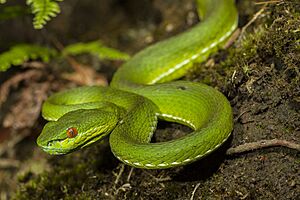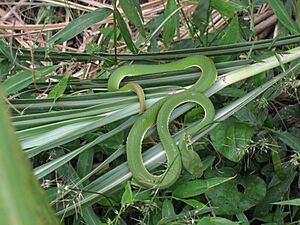Trimeresurus stejnegeri facts for kids
Quick facts for kids Trimeresurus stejnegeri |
|
|---|---|
 |
|
| Conservation status | |
| Scientific classification | |
| Genus: |
Trimeresurus
|
| Species: |
stejnegeri
|
| Synonyms | |
|
|
Trimeresurus stejnegeri is a type of venomous pit viper snake found only in parts of Asia. It's known by many names, like Stejneger's pit viper or Chinese green tree viper. This snake is famous for its bright green color and its strong venom. There are two main types, or subspecies, of this snake that scientists recognize.
Contents
What's in a Name? (Etymology)
The scientific name, stejnegeri, honors a famous scientist named Leonhard Stejneger. He was a Norwegian-born American herpetologist. A herpetologist is someone who studies reptiles and amphibians. Stejneger worked at the Smithsonian Institution for over 60 years.
Appearance and Features (Description)
The Stejneger's pit viper can grow up to about 75 centimeters (nearly 30 inches) long. This includes its tail, which can be about 14.5 centimeters (about 5.7 inches) long.
This snake has special scales on its back, usually in 21 rows around its middle. It has 9 to 11 scales above its mouth, and the first ones are separate from its nose scales. There are also 11 to 16 scales in a line between its eyes. On its belly, it has 150 to 174 scales, and under its tail, it has 54 to 77 pairs of scales.
The snake's body is usually bright to dark green on top. Its belly is pale green or whitish. A special stripe separates these two colors. In males, this stripe is bright orange or brown on the bottom and white on top. In females, it can be bicolored or just white. This stripe covers the entire outer row of scales and part of the second row.
These snakes are carnivores, meaning they eat meat. They hunt and eat small rodents, birds, frogs, and lizards. Sometimes, you might even see a rare yellow-colored one, which is a natural color variation.
Other Common Names
People call T. stejnegeri by many different names. These include bamboo viper, Chinese tree viper, bamboo snake, Chinese green tree viper, Chinese bamboo viper, Stejneger's pit viper, Stejneger's palm viper, red tail snake, and Stejneger's bamboo pitviper.
Where They Live (Geographic Range)
You can find Trimeresurus stejnegeri in several parts of Asia. They live in Northeast India and Nepal. Their range extends through Myanmar and Laos. They are also found in much of southern China, including many provinces like Yunnan, Sichuan, and Fujian. You can also find them in Vietnam and Taiwan.
Their Home (Habitat)
These snakes prefer to live in forests. They can be found from sea level all the way up to about 2,000 meters (about 6,560 feet) high in the mountains.
About Their Venom
Trimeresurus stejnegeri has a strong venom that affects the blood. If someone is bitten, the wound usually feels very painful, like a burn. This intense pain can last for about 24 hours. Soon after a bite, the area around the wound can swell quickly. The skin and muscle might turn dark because of tissue damage. How much the area is affected depends on how much venom was injected and how deep the bite was. It's important to get medical help right away if someone is bitten by this snake.
Life Cycle (Reproduction)
T. stejnegeri snakes are viviparous. This means that the mother snake gives birth to live young, rather than laying eggs. The babies develop inside the mother's body until they are ready to be born.
Different Types (Subspecies)
There are two recognized subspecies of Trimeresurus stejnegeri:
| Subspecies | Scientist Who Named It | Common Name | Where It Lives |
|---|---|---|---|
| T. s. chenbihuii | Zhao, 1997 | Chen's pit viper | China, specifically on Hainan Island. You can find it on Mount Diaoluo and Wuzhi Mountain. |
| T. s. stejnegeri | Schmidt, 1925 | Stejneger's pit viper | China (in eastern Sichuan, Guizhou, Hubei, Anhui, Jiangsu, Zhejiang, Jiangxi, Hunan, Fujian, Gansu, Guangdong and Guangxi), Taiwan, and Vietnam. |



